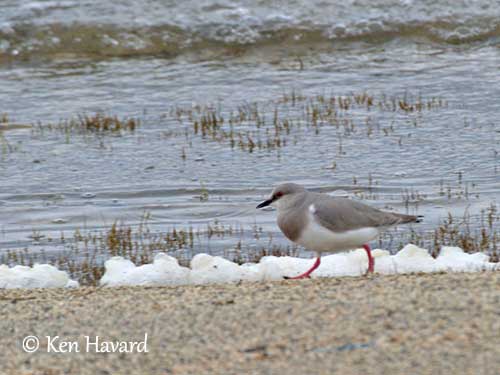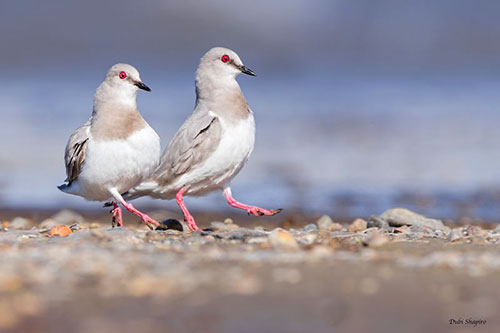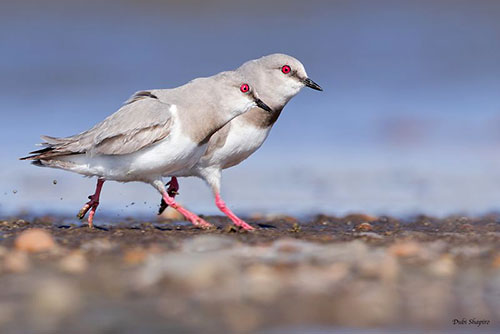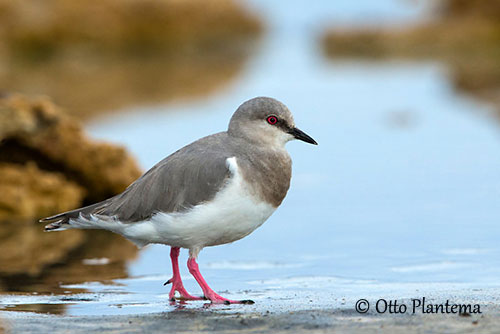
Fr: Pluvianelle magellanique
Ang: Magellanic Plover
All: Magellanregenpfeifer
Esp: Chorlito de Magallanes
Ita: Piviere di Magellano
Nd: Magelhaenplevier
Sd: magellanpipare
Photographers:
Ken Havard
My Bird Gallery & Flickr gallery 1 & Flickr gallery 2
Otto Plantema
Trips around the world
Dubi Shapiro
Dubi Shapiro Photo Galleries
Text by Nicole Bouglouan
Sources:
HANDBOOK OF THE BIRDS OF THE WORLD Vol 3 by Josep del Hoyo-Andrew Elliott-Jordi Sargatal - Lynx Edicions - ISBN: 8487334202
SHOREBIRDS by Peter Hayman, John Marchant and Tony Prater – Christopher Helm – 1986 – ISBN: 0747014035
Nature Guide Birds of the World Par DK – Editeur : Dorling Kindersley Ltd, 2012 – ISBN: 1409375471, 9781409375470
CREAGUS@Monterey Bay (Don Roberson)
Wikipedia, the free encyclopaedia
Neotropical Birds – Cornell Lab of Ornithology
Fatbirder - Pluvianellidae - Magellanic Plover
Far South Expeditions - Magellanic Plover, Pluvianellus socialis, a shorebird on a class of its own
Magellanic Plover
Pluvianellus socialis
Charadriiformes Order – Pluvianellidae Family
INTRODUCTION:
The Magellanic Plover is confined to the southern tip of South America. This dove-shaped wader has turnstone-like morphological and behavioural features, including the habit of turning seaweeds and stones to reach invertebrates.
But recent analysis of morphological and osteological characters leads to evidence that this is not a typical plover, but a species rather more closely related to Chionidae (sheathbills) than any other Charadriiformes. However, the Magellanic Plover is quite a different bird from sheathbills, even being the closets living relative, involving the treatment of Pluvianellidae as a monotypic family.
The Magellanic Plover breeds around upland lakes in Tierra del Fuego, and moves northwards to coastal Patagonia after breeding. It carries food to the chicks in the crop, a pouch which can also be distended during the displays.
The Magellanic Plover is scarce. Its breeding habitat is affected by destruction of natural grassland in Patagonia by livestock, and the nests are threatened by trampling by grazing animals. Human disturbance and predation by cats and dogs, with in addition the degradation of estuarine habitats by pollution, make this species particularly vulnerable. It is currently listed as Near Threatened.

DESCRIPTION OF THE BIRD:
Biometrics:
Length: 19,5-21,5 cm
Weight: M: 79-102 g – F: 70-87 g
The Magellanic Plover is a beautiful grey-and-white wader in all plumages.
The adult has soft grey upperparts and breast, but lower breast is tinged brown. Chin, throat and underparts are white, including underwing and axillaries.
In flight, the upperwing shows conspicuous white wingbar contrasting with the dark flight-feathers. The uppertail is whitish with black central pair of rectrices.
The head is grey on crown and nape. Lores are blackish. Cheeks and forehead are white.
The short, pointed bill is black with purplish patches at base of culmen and lower mandible. The eyes are pinkish-red. Short legs and strong feet are pinkish-red.
Male and female have similar plumage, but the female is slightly smaller than male.
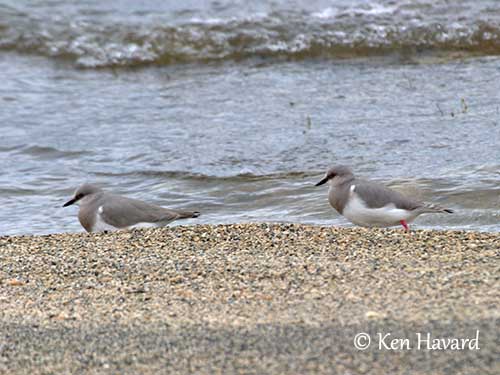
The juvenile has the upperparts extensively spotted and fringed with white. The greyish breast is slightly streaked dark grey. The lores are pale and lack the dark line.
The bare parts are duller. The bill shows extensive yellow over culmen. The eyes are orange-grey. Legs and feet are more yellowish than on adults.
RANGE:
The Magellanic Plover breeds in S Argentina and extreme S Chile. It winters N to Valdés Peninsula, and sometimes as far as Buenos Aires Province in SC Argentina.
HABITAT:
The Magellanic Plover breeds in grassland around high-elevation freshwater and brackish lakes and lagoons, and can be seen up to 1,200 metres. After the breeding season, it migrates to the coast in sheltered bays and rivers mouths.
CALLS AND SONGS: SOUNDS BY XENO-CANTO
The Magellanic Plover most frequent call is a ringing “coo” or “ceu” ranging between a dove and a plover. We can also hear an ascending whistle “weeEEEEooooo” and the alarm call is a “pip-wheet”.
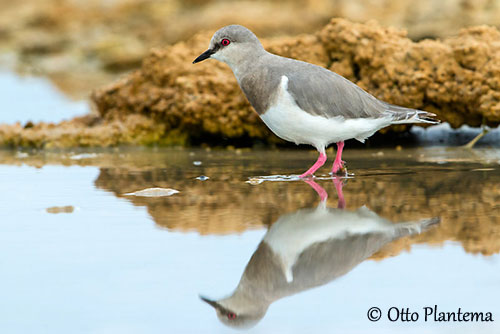
BEHAVIOUR IN THE WILD:
The Magellanic Plover feeds on shrimps, sandhoppers (amphipod crustacean of sandy shores) and tiny arthropods.
It pecks food from surface and turns over small stones, seaweeds, shells and debris with its strong bill to find food. It also uses its powerful legs and feet to scratch or dig into the sand for hidden prey, behaviour unique among waders.
It is always active and runs fast while foraging. It can be seen in small foraging flocks outside the breeding season.
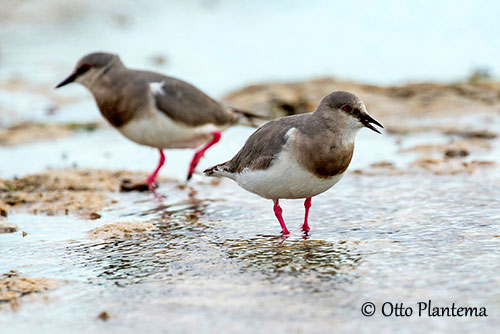
The cryptic coloration of this wader makes it difficult to find, especially as it blends with the pebbles that are part of its natural habitat.
The Magellanic Plover is resident, dispersive and migratory. After the breeding season, it moves to coast N to Valdés Peninsula and occasionally to SW Buenos Aires Province and Falkland Islands.
The most important non-breeding area is the Río Gallegos estuary where the species is present between late March and early August.
The flight is strong and fast, but often erratic with rapid flicks of the wings.
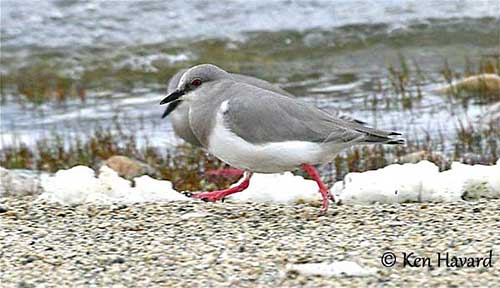
REPRODUCTION OF THIS SPECIES:
The Magellanic Plover breeds in early spring, with the laying between early September and mid-November.
It nests on the ground, on the gravelly stones of lakes and lagoons. It defends the territory against other pairs. The nest is an exposed scrape lined with gravel. It is placed on the bare shores of lakes, very close to water, even with unstable water levels. This species may produce up to three clutches per season.
The female lays 1-2 large eggs directly on the ground. Both adults share the incubation during 24 days. At hatching, the chicks have finely mottled rufous and dusky down, with some downy white tips. They are usually weak. They are fed by both parents until after fledging. They are sometimes fed by regurgitated food carried in the well-developed adult’s crop, another unique behaviour among waders.
The young fledge between 28 and 35 days after hatching, and still depend on parents for ten days more.
The second-hatched chick is usually very weak and often dies by starvation. The nest are sometimes visited by predators or trampled by grazing cattle.
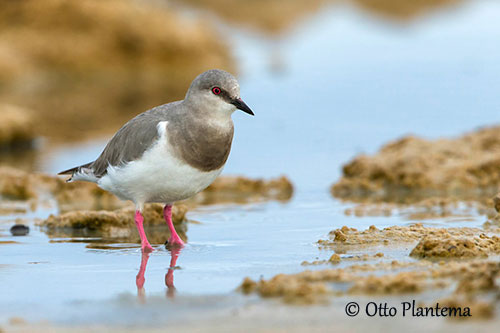
PROTECTION / THREATS / STATUS:
The Magellanic Plover is affected by destruction and degradation of grasslands by livestock in Patagonia. Trampling of nests by cattle and predation by cats and dogs are also potential threats. The wintering habitats, and especially estuaries, are degraded by oil-spills, garbage dumping and sewage. The species is at least present in four protected areas.
The population perhaps does not exceed 1,500 birds, but it has been suggested that numbers may be as high as 10,000 individuals. The species is now known to be more widespread in breeding season than previously supposed. This population is currently placed in the band 1,500/7,000 mature individuals.
The Magellanic Plover is currently listed as Near Threatened.
